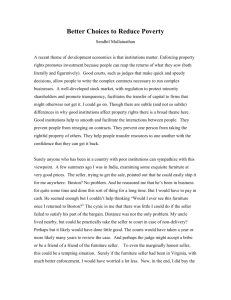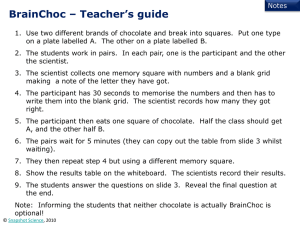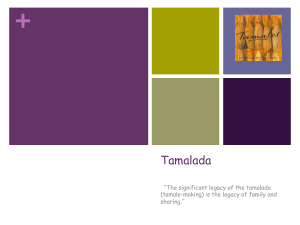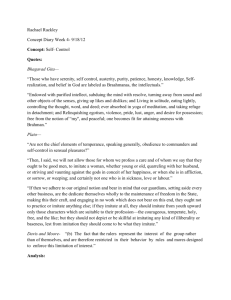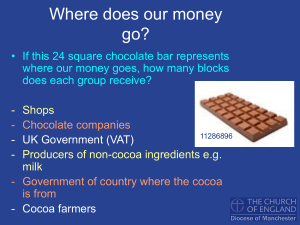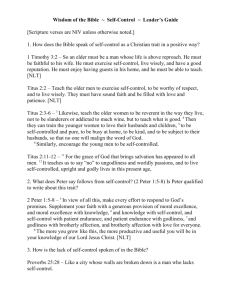Impulse buying and Consumer Self
advertisement
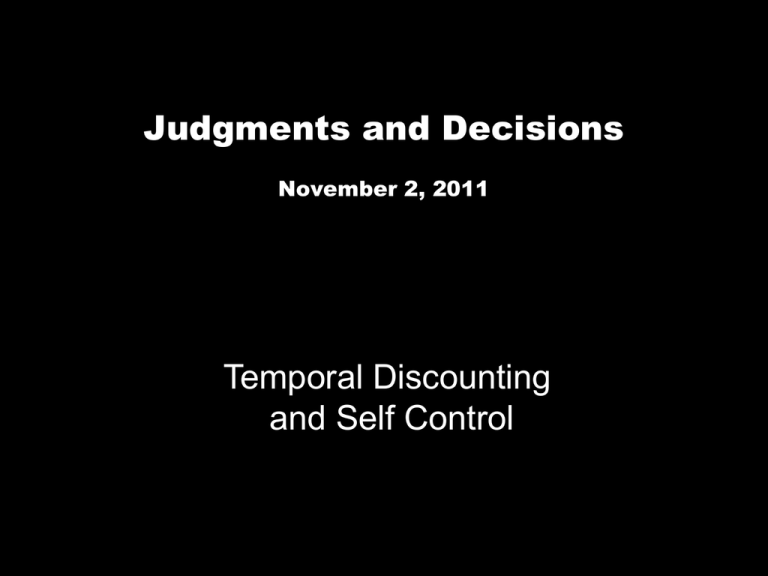
Judgments and Decisions November 2, 2011 Temporal Discounting and Self Control • What would you rather have? A. $100 today B. $150 a year from now • Temporal discounting of future money implies that the utility of money decreases with time. • What would you rather have? A. $100 today B. $110 in a month • What would you rather have? A. $100 in 12 months B. $110 in 13 months Normative Theory of Discounting • Money should be discounted at a constant rate over time. • This implies that preferences will be consistent over time. Now vs. Later • What people want NOW often conflicts with long-term goals – Buy now vs. save for future – chocolate cake now vs. weight loss and longevity – Party now vs good grades later • The “Planner” inside us is concerned with lifetime utility, whereas the “Doer” cares only about immediate gratification. Spending vs. Saving • Economic theories of saving assume optimization, or utility maximization over the life span. • The life-cycle hypothesis says that saving at any stage of a person’s life-cycle can be predicted by finding the stream of consumption that is utility maximizing given that person’s current income and wealth, expectation of future income, and life expectancy The life cycle hypothesis: An example • Tom and Ray are identical twins in every respect except Tom, a basketball player, earned the vast majority of his money early in life, and Ray, a manager, earned the vast majority of his money late in life. • Tom ought to save his early income to increase his retirement income. • Ray ought to borrow from his future income to increase his early lifestyle income. The Data • Tom will not save enough for retirement, and Ray will not borrow to fund his young lifestyle. • Consumption drops sharply after retirement. Most saving done by Americans occurs through forced programs (home equity, pension plans, etc.) Self-control Animals and children (and some adults), when given a choice between a small immediate reward and a larger later reward tend to choose the smaller reward. Dynamic inconsistency • Example --- A dieter’s choice at time t between eating cake or fresh fruit at time T depends on whether the choice was made at t < T or t = T. • The “discount rate” depends on the time lag between decision (at t) and consumption (at T). Our preferences are not always consistent. They can change in heat of the moment • Proclaiming love in a moment of lust • Shopping on an empty stomach • Expecting to keep a zero balance on a credit card • Road rage • Suicide Can we predict how we’ll behave in the heat of the moment? Hot-cold empathy gapsLoewenstein • When in a “cold” (unemotional) state, we tend to under-appreciate the effect of “hot” states on our behavior • These hot states include emotions (e.g., anger), drives (e.g., hunger), and other feelings (e.g., pain) • Hot states focus motivation on goods that can mitigate the visceral factor What does psychology tell us about when attempts at selfcontrol are likely to fail? • When goals are vague • When we’re in a bad mood-sadness, stress • When we’re not monitoring our behavior – mindless eating in front of tv – No budget – Under the influence Self-control as a limited resource -Baumeister • Self-control works like a muscle – It can only be taxed to a certain point – It can be strengthened with work/effort • Self control is weakened by prior act of volition • Prediction: after exerting self-control in situation A, it is more difficult to do so in situation B. Chocolate and Radishes • Lab room set-up with freshbaked chocolate chip cookies and radishes • Participants were instructed to eat either radishes or chocolate chip cookies • Participants were then asked to solve impossible puzzle Puzzle Results Condition Time Spent (min) Attempts Tried Radish 8.35 19.40 Chocolate 18.90 34.29 No food control 20.86 32.81 Choice depletes willpower • Controlling for time spent shopping and other demographic factors, shoppers who made a lot of choices that day spent less time on the math problems and got fewer correct. Depletion can lead to impulse buying • Conflict between control and indulgence • Often cue-based—triggered by a feature of the environment • What can we do about this issue and other issues of self control? Pre-commitment devices • Sometimes people pre-commit to avoid temptation – Placing alarm clock across the room – Staying out of bars – Christmas clubs – Individual snack packs – ATM limits – www.Stickk.com Pre-commitment in Action Micro-Savings in the Philippines Ashraf, Karlan, and Yin 2006 • “Commitment savings accounts” • 707 banks clients offered accounts; 202 signed up – Same interest rates, but imposed restricted access until an end date • 12 months later, average savings was 81% higher compared to control group Rationing vices • People tend to be less price sensitive for vices than for virtues • Example: They may buy one pack of cigarettes when they could easily afford a 10-pack carton. Other self-control tools • Anticipatory feelings (e.g., regret) • Moral values/ Guilt, Shame • Policy Policy interventions The Save More Tomorrow Plan (SMarT) • People pre-commit to saving more in the future. • Saving increases are synchronized with salary increases. • People remain in the plan unless they drop out. Results: Percentage of Salary Put into Savings ALL No Advice Took Advice Took SMarT Declined Advice 315 29 79 162 45 Pre-advice 4.4% 6.6% 4.4% 3.5% 6.1% 1st Pay Raise 7.1% 6.5% 9.1% 6.5% 6.3% 2nd Pay Raise 8.6% 6.8% 8.9% 9.4% 6.2% 3rd Pay Raise 9.8% 6.6% 8.7% 11.6% 6.1% 4th Pay Raise 10.6% 6.2% 8.8% 13.6% 5.9% N

